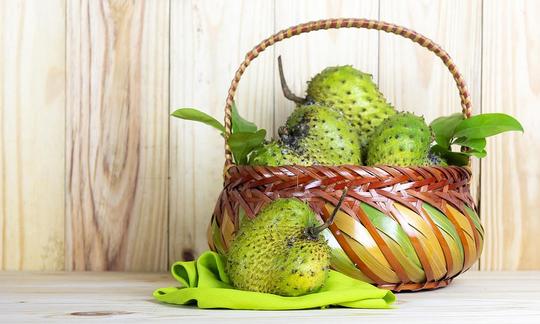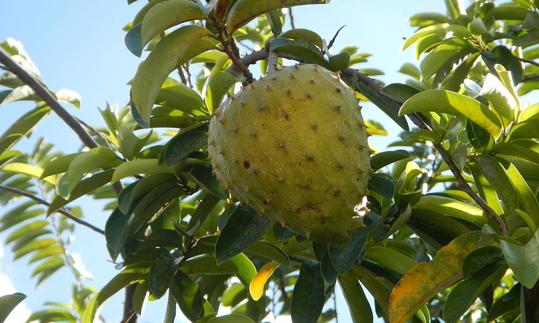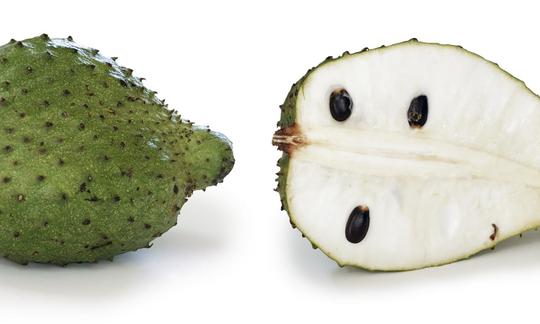The soursop ( Annona muricata), also called graviola, soursop, guanabana or guyabano, has a frightening effect due to its prickly appearance. It is closely related to the cherimoya.
Use in the kitchen:
The soursop is a melon-sized, yellow-green fruit with many spines. It can weigh up to four kilograms and reach a length of over 30 cm.
To eat or process the exotic fruit, it should be a little soft all over and give way easily when pressed with your fingers. When ripe, the fruit gives off a very pleasant, lemony scent. The flesh of the soursop is white-yellow, creamy, juicy and has a slightly sour taste. The black, elongated seeds are in the pulp. 1
To eat the fruit raw, halve it and scoop out the pulp from the skin. As with other custard apples, the seeds are not edible. The skin is also inedible. If you separate the poisonous seeds from the pulp, you can use the pureed graviola pulp with other fruits to make a tasty, refreshing mixed drink.
Graviola fruits are used in different ways in different regions. In Indonesia, the fruit is used to make pudding. In the Philippines, graviola is used as a vegetable, with a taste reminiscent of corn.
Purchasing - where to buy?
Soursops are rarely found in Europe. They are not suitable for export because they are too sensitive. You will not find a high-quality fruit in your nearest supermarket or at a major retailer such as Coop, Migros, Denner, Volg, Spar, Aldi, Lidl, Rewe, Edeka or Hofer. You may be able to get a soursop in season (main harvest time is June to September) 10 in an organic store, a specialised fruit dealer, an Asian shop or an online store. A poor quality guanabana will not live up to its health promises. So look for appropriate certificates that ensure that the plants have not been treated with pesticides or insecticides. 2 When you buy the fruit, it is usually still unripe and still needs to ripen (climacteric).
Juice made from the fruit is available worldwide. Make sure that you only buy juice with 100% pulp, as many commercial products are diluted with water. The juice should be bottled in a glass bottle if possible. Store in a cool place.
You can buy soursop tree leaves for tea. However, these must be natural. Too much heat and UV radiation will cause many of the leaves' vital substances and vitamins to be lost. Here too, it is very important to buy premium quality without additives.
It is possible to find jam or frozen, high-calorie graviola fruit puree in health food stores or delicatessens. The valuable ingredients are preserved even when frozen.
Found in the wild:
The Graviola tree is found in the wild in the Amazon region. For the natives, it is a gift from nature. People value the fruits as a delicious food and use the leaves as a traditional medicine.
Storage:
The soursop usually needs to ripen further. The fruit is very sensitive to pressure and only lasts for a short time. Fully ripe fruit only lasts one or two days in the fridge. The frozen pulp can last up to 4 months.
Ingredients - nutritional value - calories:
The flesh of the soursop is rich in vitamins, minerals and carbohydrates. As in almost every fruit, there is a lot of vitamin C and the various B vitamins. See the ingredient tables below this text. The antioxidants and lipids contained in the fruit also protect our immune system.
What is interesting about graviola is the group of substances consisting of forty natural, so-called annonacene acetogenins, which only occur in the Annonaceae family. The annonacene acetogenin compounds are present in the leaves, stems, bark, fruits and seeds. These have anti-inflammatory and analgesic effects. The inedible seeds contain annonacin, a poisonous alkaloid.
Health aspects - effects:
In the countries where the guanabana is native, all parts of the plant are traditionally used. The leaves of the soursop have a calming effect, help to stabilize blood circulation and prevent vascular constriction. They can also support milk flow in nursing mothers. The active substances also have antibiotic, antiviral and antiparasitic properties. The soursop is even said to help against nausea and vomiting during chemotherapy. 3,4,5,6
Cancer research is also interested in the mechanisms of action of the soursop. A clear effect of the substances from the graviola tree has not yet been proven. Scientific studies differ considerably. Isolated laboratory studies indicate that the acetogenins have a positive effect on the behavior of cancer cells. There have not yet been any studies on humans. There are no studies that prove that graviola substances are effective as cancer drugs. Researchers also do not know what dose and what period of time makes sense to take them. Laboratory tests (in vivo on mice) show that graviola fruit extracts inhibit the growth of certain breast cancer and pancreatic cancer cells. 4,5
Cancer Research UK has published a long report detailing the positive and negative effects that Annona muricata can have as a herbal remedy. Since 1970, one of the largest American pharmaceutical companies has been interested in the promising properties of this fruit and tree. The anti-cancer effects have been extensively researched. However, it has not been possible to produce the active ingredients synthetically. The results are still not available to the public. There are no patents on natural remedies.
However, the researchers do not rule out that the fruits, leaves and bark of the tree could be helpful in treating some diseases. 7
Dangers - Intolerances - Side effects:
The seeds and roots of the soursop are poisonous. Like the other Annonas, they contain the neurotoxin annonacin. It is used as an insecticide and causes severe nausea. 1
The neurotoxin annonacin contained in the seeds of the soursop is said to be the cause of a neurodegenerative disease. This disease only occurs on the Caribbean island of Guadeloupe. It is suspected that there is a connection with the consumption of plants containing annonacin. The French food safety authority ( Agence française de sécurité sanitaire des aliments) contradicts this, as the results are based only on laboratory and animal tests. 8
People with blood pressure problems should only take the fruit, tea or any other form of the soursop plant after consulting their doctor. The vasodilating and blood pressure-lowering effects of the substances in the plant can have unpleasant consequences . Pregnant women are also advised not to take soursop in any form. The active ingredients of the plant can induce labor. 2
Folk medicine - natural medicine:
Guanabana leaves have always been used in South America to make tea. It helps with digestive and liver problems, bladder infections, skin problems, sleep disorders, and circulatory and respiratory problems. The tea is also used to treat fever.
Internal parasites, worms, fleas and other vermin can be driven away with the substances from the soursop. Although researchers have been trying to confirm the effectiveness of the plant since the 1940s, there has not yet been any scientific proof that the plant's ingredients really alleviate or even cure these illnesses and complaints. These are the experiences of the local population. 1
Occurrence:
The evergreen tree of the soursop reaches a height of 8-12 meters and comes from the tropical rainforests of Latin America and the Caribbean. The fruits are known there under the name guanabana or guyabano. The plant grows everywhere where there is a tropical climate. After discovering America, the Spanish brought the trees and the fruits to Europe. From there, the plants were exported to Africa, India, Ceylon, Southeast Asia and Australia, where they now thrive on plantations. A major production site for guanabana is Hawaii. From there, the fruits are sent to North America.
Cultivation - Harvest:
Graviola trees need a frost-free location for cultivation, although they can withstand brief periods of subzero temperatures. The trees do not tolerate oxygen-poor, calcareous or dry soils.
The pickers of the soursops have only a narrow window of time between harvest and ripening. The fruits are picked shortly before they are ripe so that they do not fall to the ground and burst. 3
Danger of confusion:
The Annona family includes some very similar looking fruits. The Cherimoya, the Nettle Soursop, the Scale Soursop and the Atemoya all look very similar. The Soursop, however, stands out because of its size and especially because of its spines. If you only compare the leaves, the trees and shrubs from the Annona group are difficult to distinguish.
General information:
The soursop ( Annona muricata) belongs to the family of annona plants. In the 16th century, the natives of Haiti originally called the various fruits "Anon", which means custard apple. The botanist Linnaeus Latinized the popular name and changed it to Annona. 1
The annacin contained in the seeds acts against the larvae of the yellow fever mosquito. This mosquito transmits the dangerous dengue virus. 9
| Wiss. N. | English | German | Common names* | Artificial names** |
| Annona cherimoya | Cherimoya, Custard apple | Cherimoya | Jamaica, cream, sugar apple, sweet sack | Annona (wrong for all!) |
| Annona sylvestris | Wild sweetsop, Bull's heart, Bullock's heart, Ox heart | Net Annone | Oxheart, sweet apple, Buddha fruit, Sharifa | Custard apple, Cachiman |
| Annona squamosa | Sugar apple, Sweetsop | Soursop | Cinnamon Apple | Cream apple, sweet sack, custard apple |
| Annona muricata | Soursop, Graviola, Guyabano | Soursop | Sauersack, Graviola, Guanabana, Corossol | |
| Annona mucosa J | Wild sugar apple | Slime apple | Rollinia mucosa | Biribá, wild sweetsop |
| Annona senegalensis | African custard apple, wild custard apple, wild soursop | Senegalese Annona | Monkey food, Senegalese apple | |
| Annona purpurea | Soncoya | Annona purpurea | Annona manicote | |
| Annona macro-prophyllata | Ilama | Ilama | Annona diversifolia | |
| cherimola x squamosa | Atemoya | Atemoya |
| The name Annone or Anone (anón) is the genus name, which is why it is mistakenly used as the name for every species. This name is not specific. In many image collections such as fotolia, Adobe, pixabay, etc., species are confused with Cherimoya or with other names. *Common names are terms that, according to Wikipedia, come from everyday language and are easier to understand. **Artificial names are new artificial names that are sometimes derived from real common names, but are often fantasy names. |
Literature - Sources:
- Rohkostwiki.de, Soursop
- Graviola.info
- Zeitung.de Graviola.
- Dai Y, Hogan S, Schmelz EM, Ju YH, Canning C, Zhou K. Selective "growth inhibition" of human breast cancer by graviola fruit extract in vitro and in vivo involving downregulation of EGFR expression. PubMed. 2011 Jun;63(5):795-801. doi: 10.1080/01635581.2011.563027.
- Torres MP, Rachagani S, Purohit V, Pandey P, Joshi S, Moore ED, et al. Graviola: a novel promising natural-derived drug that inhibits tumorigenicity and metastasis of pancreatic cancer cells in vitro and in vivo through aging cell metabolism. 2012 Oct;323(1):29-40. doi: 10.1016/j.canlet.2012.03.031.
- Yuan S, Chang H, Chen H, Yeh Y, Kao Y, Lin K, et al. Annonacin, a mono-tetrahydrofuran acetogenin, arrests cancer cells at the G1 phase and causes cytotoxicity in a Bax- and caspase-3-related pathway. Life Sciences. 2003;72:2853–2861. doi:10.1016/S0024-3205(03)00190-5.
- Medizin-transparent.at Graviola Cancer
- AFSSA Agence française de sécurité sanitaire des aliments. Avis de l'Agence française de sécurité sanitaire des aliments relative to risques liés à la consumption de corossol et de ses preparations. 2010.
- Grzybowski A, Tiboni M, Da Silva M, Chitolina R, Passos M, Fontana JD. The combined action of phytolarvicides for the control of dengue fever vector, Aedes aegypti. Revista Brasileira de Farmacognosia. 2012;22:549–557. doi:10.1590/S0102-695X2012005000026.
- hort.purdue.edu-newcrop-morton-soursop-html












Comments